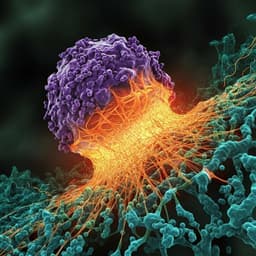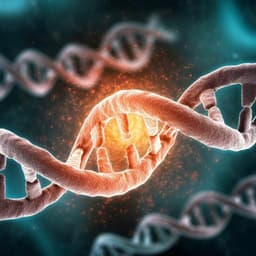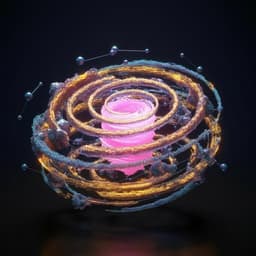
Chemistry
Acoustically shaped DNA-programmable materials
Z. A. Arnon, S. Piperno, et al.
This groundbreaking research showcases a unique fabrication technique that merges DNA-programmable assembly with acoustic field control, enabling the creation of intricate macroscale shapes with unmatched nanoscale precision. Authored by Z. A. Arnon and colleagues, this work paves new paths in DNA nanotechnology, revealing vital growth processes through advanced microscopy and x-ray scattering.
Playback language: English
Introduction
The unique properties of nanomaterials hold immense promise for various applications. However, translating these properties to bulk materials and devices requires precise control over macroscale morphology, a challenge arising from the dominance of kinetic effects at larger scales and the limitations of thermodynamic processes that typically result in equilibrium morphologies. Current methods for nanomaterial generation often produce only small mesoscale structures, hindering practical applications. This work addresses this challenge by combining the thermodynamically controlled, precise nanoscale organization of DNA-programmable self-assembly with out-of-equilibrium processes driven by acoustic fields. DNA-guided self-assembly provides defined nanoscale control and the ability to generate diverse inorganic framework architectures. The tunability of DNA Watson-Crick base pairing allows the design of programmable materials with controlled organization at the nanometer length scale. While DNA origami techniques allow for the creation of intricate nanoscale structures, shaping these into desired macroscale morphologies remains a significant obstacle. Existing methods for macroscale morphology control, such as using light, magnetic, or electric fields, often require specific material properties, limiting material diversity. Acoustic fields offer a more versatile alternative, requiring only a non-zero acoustic contrast factor between the assembled components and the medium, making them broadly applicable to diverse materials. This study investigates the use of acoustic fields, specifically Standing Surface Acoustic Waves (SSAW), to shape DNA-assembled materials at the millimeter scale, bridging the gap between nanoscale precision and macroscale control.
Literature Review
The literature review highlights the significant advancements in DNA nanotechnology for assembling nano-components with nanoscale precision. Several studies demonstrate the use of DNA origami to create ordered three-dimensional (3D) nanomaterials with various inorganic framework architectures. The tunability of DNA base pair interactions enables the design of programmable materials with controlled nanoscale organization. However, existing methods struggle to translate this nanoscale control to macroscale morphologies. The authors review methods utilizing external factors such as light, magnetic, and electric fields for macroscale morphology control but note their limitations in terms of material compatibility and diversity. The use of acoustic fields is presented as a more versatile alternative due to its reliance on acoustic contrast factors, which are less restrictive than requirements imposed by other methods.
Methodology
The experimental system utilizes two complementary DNA octahedral origami frames (approximately 30 nm edge length) that self-assemble into a crystalline organization with a simple cubic lattice. The nucleation and growth of these lattices are manipulated through thermal annealing and acoustic stimulation. The acoustic setup involves interdigital transducers (IDTs) that generate SSAW, creating a pattern of linear nodes within a sealed glass capillary containing the DNA solution. The authors explore two approaches: First, they use SSAW to organize pre-assembled micron-sized DNA crystallites into linear patterns within the nodes. Second, they investigate the effect of applying SSAW pulses during the initial crystal nucleation and growth, combined with thermal annealing. The SSAW pulses induce local heating and potentially influence nucleation and growth dynamics. The key parameters investigated include thermal protocols (different annealing rates), pulse duration (50 ms), and the period between pulses (τ), which is varied to determine its effect on crystal size. Optical and electron microscopy are used to visualize the assembly process and characterize the morphology of the resulting structures. Small angle X-ray scattering (SAXS) is employed to confirm the nanoscale structure of the lattices. A computational model incorporating nucleation dynamics, diffusion-limited crystal growth, and the effects of acoustic driving is developed to explain the experimental observations. The DNA origami frames were designed using caDNAno software and synthesized via standard protocols involving mixing scaffold and staple strands, heating, and cooling for folding and subsequent purification. The acoustic experiments involved carefully positioning a capillary containing the DNA solution between the IDTs, applying SSAW pulses with varied parameters, and observing the crystal formation via microscopy.
Key Findings
The study demonstrates that specifically shaped acoustic pulses can direct the formation of DNA-assembled materials into macroscale morphologies according to the shape of the standing wave nodes. SSAW pulses enhance nucleation and crystallization, leading to the assembly of larger crystallites. The authors successfully organize pre-formed DNA crystals into linear patterns within the capillary nodes using SSAW. A thermal reannealing process, combined with acoustic field confinement, fuses these crystals into a single, elongated macroscale morphology. The study shows that varying the ratio τ (period/pulse) of SSAW pulses during crystal growth significantly influences crystal size. A specific τ value (τ = 20) results in significantly larger crystals compared to those formed without acoustic stimulation. A computational model, incorporating nucleation dynamics, diffusion-limited growth, and the effects of acoustic driving, accurately predicts the observed crystal size distributions, explaining the effect of the SSAW pulses. The model suggests that SSAW suppress nucleation in the active region while causing an influx of smaller clusters from the adjacent region, acting as nuclei for crystal growth. The resulting macroscale structures retain the nanoscale simple cubic lattice organization as confirmed by SAXS, indicating that the acoustic field affects crystallite growth without altering the internal nanoscale arrangement. The combined method allows for control over structure formation across six orders of magnitude (sub-nm to mm).
Discussion
The findings address the challenge of translating nanoscale precision in DNA self-assembly to macroscale control. The combination of DNA-guided assembly and acoustic field manipulation achieves unprecedented control over material morphology across a vast range of scales. The ability to precisely shape macroscale structures while maintaining nanoscale organization opens exciting possibilities for creating complex, functional materials. The successful computational modeling strengthens the understanding of the underlying physical processes involved, particularly the interplay between nucleation, growth, and acoustic driving. The non-monotonic relationship between τ and crystal size highlights the complex dynamics influenced by both suppressed nucleation and the influx of nuclei. The ability to extend this method to various DNA-programmable materials, including those with embedded functional components like nanoparticles, expands its potential applications.
Conclusion
This work demonstrates a novel approach for fabricating macroscale morphologies of DNA-programmable nanomaterials using acoustically driven assembly. The method allows for precise control over both nanoscale organization and macroscale shape. Future research could explore the use of more complex acoustic field patterns to create intricate 2D and 3D structures, potentially utilizing acoustic holography. Expanding this approach to incorporate diverse functional components and exploring new applications in areas like photonics, mechanics, and biomaterials are promising avenues for future investigation.
Limitations
The current study focuses on linear macroscale morphologies. While the authors suggest the potential for creating more complex shapes, this remains to be experimentally demonstrated. The computational model, while providing valuable insights, is a simplified representation of the complex physical processes involved. Further refinement of the model could incorporate more detailed descriptions of acoustic energy dissipation and fluid dynamics within the capillary. The study primarily focuses on a specific DNA origami structure and specific acoustic parameters; future work could investigate the generalizability of the method to other DNA structures and acoustic conditions.
Related Publications
Explore these studies to deepen your understanding of the subject.







